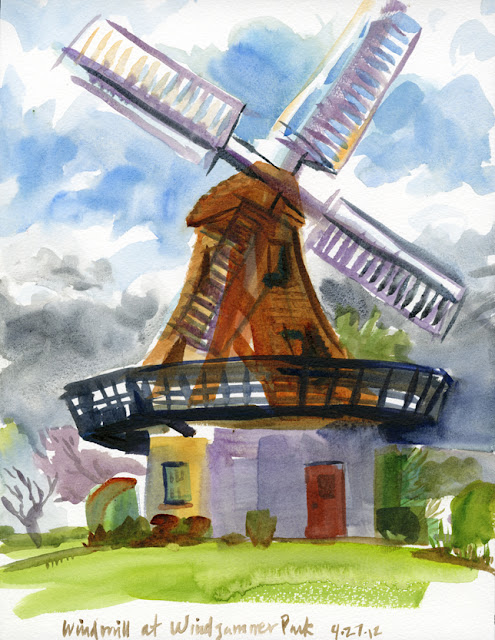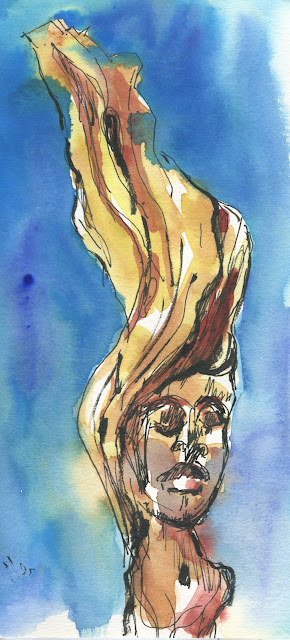It was great fun to join the Whidbey Island Sketchers on Friday in Oak Harbor! Sat by a hedge that blocked the wind and tried to sketch the windmill. Here it is!
Minggu, 29 April 2012
Sabtu, 28 April 2012
An Oak Harbor Afternoon
In honor of Oak Harbor's Holland Happening this weekend, we gathered at Windjammer Park to sketch the ochre windmill and tulips. I loved seeing the windmill sketched in so many different styles by all the sketchers.
But Windjammer Park got windy so we reconvened at Flyers for great gab and sketching. One of Whidbey Island Sketchers' best days.
But Windjammer Park got windy so we reconvened at Flyers for great gab and sketching. One of Whidbey Island Sketchers' best days.
 |
| Beautiful Faye |
Marathon Sketch Meet
It was one for the record books, I think. Great turnout of fun sketchers yesterday. Driven indoors by the cold and wind, we each managed one sketch of the windmill at Windjammer Park before repairing to Flyers Restaurant, where the real sketching began. So much fun!
 |
| Windjammer Park |
 |
| Mike, Kris, Lisbeth |
 |
| Beautiful young boy sitting at the next table. |
 |
| Cowboy |
 | |||
| I am a sucker for curly red hair. |
 |
| It doesn't get much looser than this! |
 |
| Couple at Flyers |
Our apple tree...and a very fun sketch session
And it's spring at Windjammer Park in Oak Harbor. The wind was a little cold so we moved on indoors to Flyers. Much fun sketching and catching up over food and wine. So much to draw there....
Big Bite!
Fellow Sketcher
And more of us......!
Jumat, 27 April 2012
Windjammer Park and Flyers
Elmer the Wooden Shoe Carver
Kinda fun. The Whidbey News-Times used my sketch of Elmer, the wooden shoe carver, on their Holland Happening wrap on this week's paper. Elmer Veldheer in 82 years old and he has been coming from his home in Holland, Michigan to carve wooden shoes during Oak Harbor's Holland Happening for 20 years! This is his last year because his arthritis is making it harder and harder to handle his carving tools. He's been a beloved fixture of Holland Happening and is being honored as the grand marshall of this year's parade.
Kamis, 26 April 2012
Selasa, 24 April 2012
St. Augustine's-in-the-Woods
A corner display of sporting gear ready for sale at St. Augustine's Trash to Treasures sale last weekend.
Harvest Moon
I spent a few days with Fallbrook friends earlier this month. Jim is a dentist and also a metal sculptor. He was working on a very cool new piece----Harvest Moon----which he had fashioned from an auger.
Senin, 23 April 2012
Sketching in the Tulip Fields
It was glorious afternoon to sketch with the Anacortes Sketchers in the middle of stunning tulip fields in full bloom in the Skagit Valley next door. So much color; so little time! Boy do we live in paradise!!
Kamis, 19 April 2012
Waiting
How does a 20 minute medical test eat up an entire 8 hour day? Lots of waiting.
 |
| Waiting in the ferry line. |
 |
| The Nurse |
 |
| The Patient (Watching CNN while he waits) |
 |
| The Artist's Foot. Nothing more to sketch in Rm. 312 except medical equipment. I decided my own foot was the most interesting subject left. |
 |
| The Redheads (in the Waiting Room) |
Springtime on Rivendell Road
I've been meaning to sketch the billowy Flowering Cherry tree in my yard before it's too late. I barely made it. Half the blossoms are already on the ground.
Selasa, 17 April 2012
Belle France
 Just back from a wonderful trip to the Beaujolais Region, Southern Burgundy and Provençe, France. Lots of sketching. These are a few of my favorites, starting with hubby's luggage packed 5 days early! Then to the long flight on Icelandair with a quick plane change in Reykjavik before heading to Paris.
Just back from a wonderful trip to the Beaujolais Region, Southern Burgundy and Provençe, France. Lots of sketching. These are a few of my favorites, starting with hubby's luggage packed 5 days early! Then to the long flight on Icelandair with a quick plane change in Reykjavik before heading to Paris. Loved sketching the vintage Citroen and several French delights such as white asparugus! Then on to our gite in St. Saturnin-lès-Apt from which we spent 6 glorious sunny days travelling to nearby villages, taking in an antique fair and pottery market, and just loving life in the French countryside!
The Long Flight
Our Gite in Provençe
Sabtu, 14 April 2012
Meerkerk Garden Gumdrops
The gumdrop shaped trees in the rock garden at Meerkerk are an interesting arrangement to paint at any angle. This garden is all about round vertical and horizontal forms. Fun to watch the light define it over the hours. This sketch isn't complete, but that may be a good thing!
Meerkerk Rhododendron Garden Path
It was a glorious, sunny day for sketching at Meerkerk Gardens. As Mike said, there is so much to sketch here, we could come back every week for the next 3 months and still not capture it all.
With this image upload I reached my 1GB limit for free storage with Google. So, now I'm paying $5/year for Google storage.
With this image upload I reached my 1GB limit for free storage with Google. So, now I'm paying $5/year for Google storage.
Jumat, 13 April 2012
Rabu, 11 April 2012
10 of the Most Endangered Animals
The extinction of at least 500 species of animals has been caused by man, most of them in this century. Today there are about 5,000 endangered animals and at least one species dies out every year. The number is rapidly growing, some species becoming endangered without most of us even knowing it. Their value is of utter importance, since they are responsible for a variety of useful medications. The first step towards saving animals is to learn as much as possible about them. So here is a look at some of the most endangered species of animals around the world:
Greater Horseshoe Bat
There are fourteen species of bat in Britain and all of them are endangered. The greater horseshoe bat is one of the rarest. There are currently 35 recognised maternity and all-year roosts and 369 hibernation sites. Current estimates range between 4,000 and 6,600 individuals. They have also suffered from the use of insecticides (poisonous chemicals sprayed on to crops to kill harmful insects) which have deprived the bats of their insect food.
Siberian Tiger
It is highly endangered and there may be fewer than 200 in the wild, probably all in special nature reserves. The are hunted because a poacher can feed his family for a year on the proceeds of just one tiger kill.
Loggerhead Turtle
This threatened reptile lives in the Mediterranean Sea, as well as the Black Sea and Atlantic Ocean. The turtle was once intensively hunted for their meat and eggs, but its fat was also used in the cosmetic industry. Many of these animals die annually caught in the fishing nets of crabfishers. In Turkey, hotels have been built right on its breeding sites.
White Tailed Fish Eagle
Before man experimented with the use of pheromones, this spectacular bird of prey was much more numerous than it is today. They have also been hunted by shepherds and gamekeepers that considered them a threat to their sheep or birds. With intense conservation actions, the populations in eastern Europe recovered, recovery plans are aimed at colonizing some traditional breeding areas in Europe.
Mandarin Duck
This bird can be seen Britain, but its native home is across eastern Asia, in Russia, China, Korea and Japa. Worldwide population status is unknown, the current Asian population being somewhere under 20,000. Extinction of these beautiful birds is due to mainly loggers, hunters and poachers. Known predators include mink, raccoon dog, otters, polecats, eagle owls and grass snakes.
Lion-Tailed Macaque
These animals live in several areas in Karnataka, Kerala and Tamil Nadu. Many of India's tropical forests, the monkey's natural habitat, have been cleared and replaced with tea and coffee plantations. As with so many mammals, currently the main threat in the wild is destruction of their habitat. Poachers have also captured baby macaques, often killing their parents in the process, for illegal export to collectors. They are considered to be the most endangered monkey, with only 400 individuals left in the wild. They are hunted for their flesh and fur.
Jackass Penguin
Once the most common sea-bird in in South Africa, the jackass penguin is the only penguin to be found in Africa. Because they live so far north, and in a relatively accessible region, African penguins have been particularly vulnerable to human depredation. Considering the decline in food supplies, seals now prey on the penguins instead. Oil pollution also threatens them, as does the taking of their eggs for food.
Mountain Gorilla
The Virunga volcanoes region in eastern Zaire, Rwanda and Uganda is the only home of the highly endangered mountain gorilla. They are frequently killed by traps and snares intended for other animals, face habitat loss and are vulnerable to many of the same diseases as humans. It depends on dense forests for survival and these are steadily being cut down to make way for crop growing and livestock grazing. Humans and gorillas are 98% genetically identical so they are also exposed to human disease. This is the most endangered of the gorilla subspecies, only about 700 mountain gorillas remain in the wild.
Numbat
They inhabit woodlands in Western Australia, this is the only state in which they are found in the wild. The numbat is now extinct throughout much of its range. It survives in the wild only in a small area in the southwest corner of Australia. When man introduced predatory animals such as cats, dogs and foxes, these animals ate many numbats. Their numbers are still declining since many of the areas that constituted their habitats are being cleared for farming and mining.
Black Footed Ferret
This is one of the most endangered mammals in North America, an animal on the edge of extinction in the wild. Loss of habitat is the primary reason black-footed ferrets remain near the brink of extinction. The remaining prairie dog colonies are small and fragmented, separated by great expanses of cropland and human development. By the year 2010, biologists hope to have 1500 ferrets established in the wild, with no fewer than 30 breeding adults in each population
Langganan:
Komentar (Atom)


































